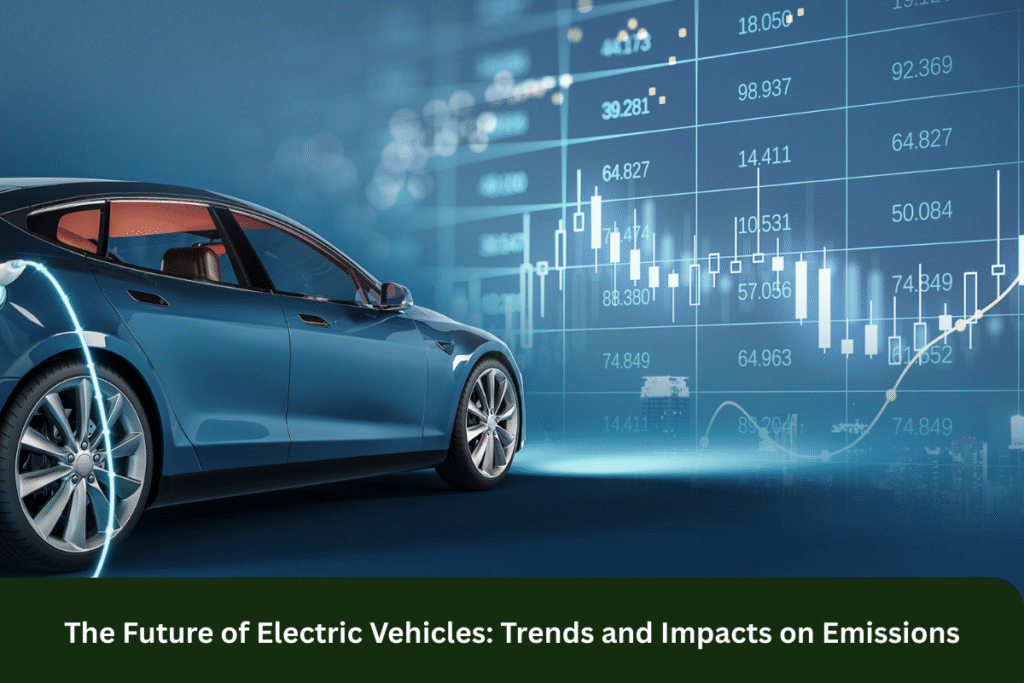
Electric vehicles (EVs) are at the forefront of the transition to a cleaner, more sustainable transportation system. With growing concerns about climate change and the environmental impacts of fossil fuels, EVs are being hailed as a solution to reduce greenhouse gas emissions and combat air pollution. In this article, we will explore the latest trends in electric vehicles, their role in emissions reduction, and the long-term impacts they will have on the environment and the automotive industry.
1. What Are Electric Vehicles?
Electric vehicles are cars, trucks, or buses that are powered by electricity, stored in batteries, rather than by internal combustion engines (ICEs) that rely on gasoline or diesel. EVs use an electric motor powered by a rechargeable battery to move the vehicle, making them far more energy-efficient and environmentally friendly compared to traditional vehicles.
The primary types of electric vehicles include:
- Battery Electric Vehicles (BEVs): Fully electric cars powered solely by electricity stored in their batteries.
- Plug-in Hybrid Electric Vehicles (PHEVs): Vehicles that have both an internal combustion engine and an electric motor, with the option to charge the battery via an external power source.
- Hybrid Electric Vehicles (HEVs): Similar to PHEVs but without the ability to plug into an external power source. They rely on a combination of the internal combustion engine and regenerative braking.
2. Current Trends in Electric Vehicles
The electric vehicle market has seen rapid growth in recent years, driven by advancements in technology, government incentives, and growing environmental awareness. Here are some key trends shaping the future of EVs:
a. Increasing Vehicle Range and Battery Efficiency
One of the main concerns with electric vehicles has historically been their range—how far they can travel on a single charge. However, advancements in battery technology are steadily improving the driving range of EVs. Today, many electric cars offer ranges of over 300 miles on a single charge, with some premium models even exceeding 400 miles.
Battery efficiency is also improving, making EVs more affordable and practical for everyday use. Innovations such as solid-state batteries promise to further enhance energy density, reduce charging times, and lower costs.
b. Expansion of Charging Infrastructure
The development of a robust and accessible charging infrastructure is essential for the widespread adoption of electric vehicles. Governments and private companies are investing heavily in building a network of charging stations, making it easier for EV owners to charge their vehicles at home, work, or on the go.
Public charging stations are becoming more common, with fast-charging networks offering the ability to recharge an EV to 80% in just 30 minutes. As more charging stations are installed, concerns about “range anxiety” (the fear of running out of charge) are decreasing.
c. Cost Reduction and Increased Affordability
As the production of electric vehicles scales up, the cost of manufacturing EVs continues to decline. The price of EV batteries, which has been a significant portion of the overall vehicle cost, has dropped dramatically in recent years. This makes electric vehicles more affordable and accessible to a broader range of consumers.
Incentives and subsidies from governments also play a crucial role in making EVs more affordable. Tax rebates, incentives for home charging equipment, and exemptions from certain fees are helping to reduce the upfront cost of purchasing an electric vehicle.
d. Government Regulations and Emissions Standards
Governments around the world are implementing stricter emissions regulations and setting ambitious goals for reducing greenhouse gases. Many countries are introducing bans on the sale of new gasoline and diesel vehicles in the coming decades, further driving the shift to electric vehicles. For example, the European Union has set a goal to achieve net-zero emissions by 2050, with the UK aiming to ban the sale of new petrol and diesel cars by 2030.
Incentives for electric vehicle adoption, including rebates, tax credits, and preferential treatment in emissions standards, are further accelerating the growth of the EV market.
e. Electric Vehicles in Public Transport and Commercial Fleets
Electric vehicles are not limited to passenger cars. Many cities are transitioning their public transportation systems to electric buses, trams, and trains to reduce emissions and air pollution. Additionally, businesses are adopting EVs for their commercial fleets, including delivery vans and trucks, as part of their sustainability efforts.
3. Impact of Electric Vehicles on Emissions
One of the primary reasons electric vehicles are considered a game-changer in combating climate change is their potential to reduce emissions.
a. Reduction of Greenhouse Gas Emissions
Electric vehicles produce no tailpipe emissions, which means they do not release pollutants such as CO2, nitrogen oxides (NOx), and particulate matter, which contribute to global warming and poor air quality. The shift from gasoline and diesel vehicles to EVs significantly reduces the carbon footprint of the transportation sector.
However, the environmental benefits of EVs are most significant when they are powered by clean, renewable energy. When EVs are charged using electricity from fossil fuels, their carbon footprint is still lower than traditional vehicles, but the full emissions reduction potential is not realized. As the electricity grid becomes greener with more renewable energy sources, the overall environmental impact of EVs continues to decrease.
b. Energy Efficiency
Electric vehicles are more energy-efficient than traditional combustion engine vehicles. The energy conversion efficiency of an electric motor is much higher than that of an internal combustion engine, meaning more of the energy from the power source is used to move the vehicle, resulting in less waste.
c. Life Cycle Emissions
While EVs have a lower carbon footprint in operation, the production of EVs, particularly the batteries, can generate higher emissions compared to traditional vehicles. However, the overall life-cycle emissions of electric vehicles are still much lower than those of gasoline and diesel vehicles, especially as battery production becomes more energy-efficient and recycling technologies improve.
4. Challenges and Considerations for the Future of Electric Vehicles
While the future of electric vehicles looks promising, there are several challenges that need to be addressed to ensure their widespread adoption:
- Battery Production and Resource Availability: The demand for lithium, cobalt, and other materials required for EV batteries is increasing. Sustainable sourcing and recycling of these materials are key to reducing the environmental impact of battery production.
- Charging Infrastructure: Expanding the availability of charging stations, particularly in rural and underserved areas, is critical to ensuring that EVs are accessible to all consumers.
- Vehicle Affordability: While prices for EVs are falling, the initial cost of an electric vehicle is still higher than traditional vehicles, limiting accessibility for some buyers. Continued cost reduction and government incentives are needed to make EVs affordable for all.
FAQs
1. How do electric vehicles reduce emissions?
2. What is the range of an electric vehicle?
3. Are electric vehicles more energy-efficient than gasoline cars?
4. What are the environmental impacts of producing electric vehicles?
5. What are the challenges facing the widespread adoption of electric vehicles?
Conclusion
The future of electric vehicles is bright, with ongoing innovations in battery technology, charging infrastructure, and government support driving their adoption. As electric vehicles continue to evolve, they will play a crucial role in reducing emissions, improving air quality, and helping to combat climate change. While challenges remain, the transition to electric vehicles represents a vital step towards a sustainable, low-carbon future for the transportation industry and the planet.
